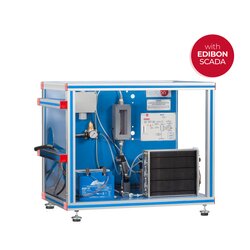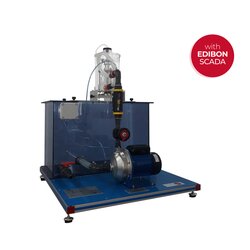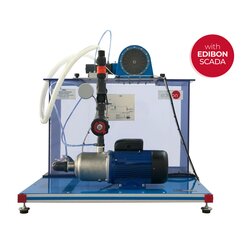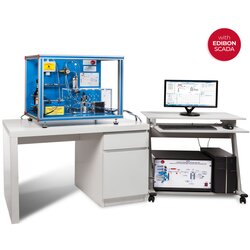Computer Controlled Biogas Processing Plant (PBGC/CTS)
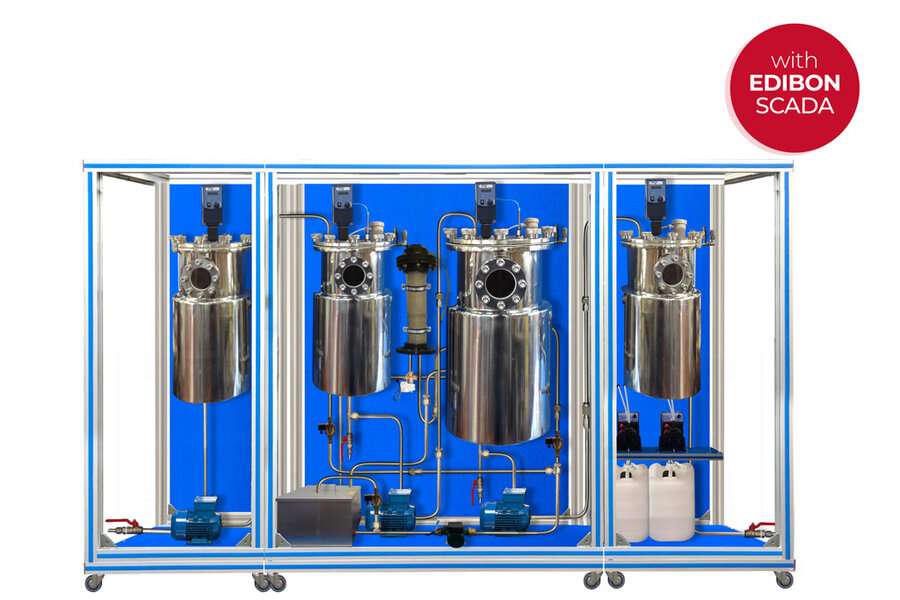


PL-560447
The "PBGC/CTS" Computer Controlled Biogas Processing Plant features two stainless steel reactors outfitted with level sensors and stirring systems, enabling flexible operation in either single-stage or two-stage processing modes. This setup supports separate digestion phases, with hydrolysis, acidogenesis, and acetogenesis occurring in the first digester, while methanogenesis takes place in the second. This separation allows for optimized conditions in each reactor.
A computer-controlled pump delivers substrate from a supply tank, equipped with a stainless steel agitator, to the first reactor. The system can run in continuous or batch mode, with an additional pump transferring the substrate to the second reactor and another moving the digestate to a collection tank, facilitating the study of post-fermentation impacts on biogas production.
Both digesters are equipped with heating jackets that use circulating hot water to regulate temperature, tailored to support specific microbial requirements. Temperature control is maintained through PID regulation, with the hot water circulating in a closed loop, heated in a dedicated tank with a heating element.
For pH regulation, two computer-controlled peristaltic pumps introduce acid or base independently into each reactor, with separate connections from the acid and base tanks. The biogas generated is passed through a silica gel drying column before reaching a measurement pipe. Here, parameters like flow rate, humidity, methane and carbon dioxide concentrations, and temperature are analyzed to assess biogas quality and energy potential.
Integrated with EDIBON’s SCADA system, this unit includes a touch screen interface and software for computer control, data acquisition, and data management, providing comprehensive monitoring and control across all process parameters.
- PBGC/CTS. Unit:
- Anodized aluminum frame and panels made of painted steel
- The unit includes wheels to facilitate its mobility.
- Main metallic elements made of stainless steel.
- Diagram in the front panel with distribution of the elements similar to the real one.
- Supply tank made of stainless steel. Capacity: 25 l.
- Three computer controlled pumps to impel the substrate. Max flow rate: 25 l/h.
- Two reactors made of stainless steel. Capacity: between 20 l – 70 l.
- Digestate collection tank made of stainless steel. Capacity: 25 l.
- pH adjustment system.
- Heating system.
- Silica gel column for biogas drying.
- Valves to select the circuits
- Sampling point with valve for external sampling of generated biogas.
- Biogas analysis section:
- Computer and touch screen control: PLC controller to control the unit locally.
The complete unit includes as well:
- Advanced Real-Time SCADA and PID Control.
- Open Control + Multicontrol + Real-Time Control.
- Specialized EDIBON Control Software based on LabVIEW.
- CTS. Computer and touch screen control.
- Calibration exercises, which are included, teach the user how to calibrate a sensor and the importance of checking the accuracy of the sensors before taking measurements.
- Projector and/or electronic whiteboard compatibility allows the unit to be explained and demonstrated to an entire class at one time.
- Capable of doing applied research, real industrial simulation, training courses, etc.
- Remote operation and control by the user and remote control for EDIBON technical support, are always included.
- Totally safe, utilizing 4 safety systems (Mechanical, Electrical, Electronic and Software).
- Designed and manufactured under several quality standards.
- Optional ICAI software to create, edit and carry out practical exercises, tests, exams, calculations, etc. Apart from monitoring user's knowledge and progress reached.
- This unit has been designed for future expansion and integration. A common expansion is the EDIBON Scada-Net (ESN) System which enables multiple students to simultaneously operate many units in a network.
- PBGC/CTS/CCSOF. PID Computer Control + Data Acquisition + Data Management Software:
- Cables and Accessories, for normal operation.
- Manuals: This unit is supplied with 8 manuals: Required Services, Assembly and Installation, Interface and Control Software, Starting-up, Safety, Maintenance, Calibration and Practices Manuals.
EXERCISES AND PRACTICAL POSSIBILITIES TO BE DONE WITH THE MAIN ITEMS
- Study of the stabilization process.
- Study of the effect of temperature on the anaerobic digestion, purification and quality of the obtained biogas.
- Study of the pH effect on the anaerobic digestion, purification and quality of the obtained biogas.
- Study of the volumetric load influence on the anaerobic digestion, purification and quality of the obtained biogas.
- Study of the type of substrate influence on the anaerobic digestion, purification and quality of the obtained biogas.
- Study of the inhibitors influence on the anaerobic digestion, purification and quality of the obtained biogas.
- Influence of the working mode, with one or two stages, on the generation of biogas.
- Influence of the working mode, continuous or batch, on the generation of biogas.
- Influence of the working mode, with or without prior fermentation, on the generation of biogas.
- Determination of the optimum operation temperature.
- Determination of the optimum feeding rate.
- Determination of the flow rate, output and quality of biogas under different working conditions.
What is this?
These percentage scores are an average of 0 user reviews. To get more into detail, see each review and comments as per below
If you have used this product, support the community by submitting your review
